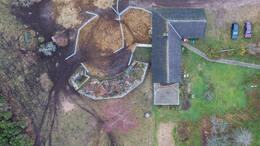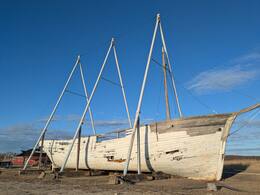How the Germans obtained fresh pork during the conquest of Hiiumaa
Sõru 1917
In October 1917, during the World War II, Germany captured the islands of Western Estonia during the daring naval operation “Albion”. For years, Tsarist Russia had built a gigantic system of fortifications around Tallinn and on the islands – the Peter the Great Sea Fortress, which unfortunately could not fulfill its mission in the chaotic conditions of 1917. As is well known, artillerymen are also needed to provide artillery fire, but when they lose their appetite for war, even the fire clubs fall silent. However, one of the few units that exchanged fire with the Germans was the Sõru 120mm coastal battery. The German battleship Bayern – the largest warship that has ever fought in Estonian waters – had run into a mine but was still capable of fighting and, together with the cannon fire of the cruiser Emden, forced the battery to fall silent and the crew to flee. Then, German mine trawlers entered the Soela Strait to clear the fairway of naval mines. At the same time, the Sõru artillery returned to their batteries and opened fire again on the enemy ships. Now the Germans sent a landing party to the beach, which destroyed the cannons. A few pigs were also requisitioned to boost the fighting spirit of the fresh meat. The road to the Väinamerri was clear. Within a few days, the entire Hiiumaa was conquered, and the Russian troops did not offer any notable resistance to the Germans.
Further reading: https://teejuht.esap.ee/eesti-ringreis/esimese-maailmasoja-operatsiooni-albion-merelahingud-soela-vainas-ja-vainamerel/
Related objects
120-mm Battery No 34 at Hindu (Sõru)
The construction of the battery began in 1914. As it was an additional battery, missing in the original plan of the naval fortress and the type of guns was repeatedly changed. Finally four 120- mm Vickers guns were installed. A 200-m length and 10-20-m width sandbar was piled up in defence of the gun emplacements and covered in concrete above the guns. Hindu was the only battery in Hiiumaa that participated in combat operations during the Tagalahe landing on 12 October 1917. After a brief exchange of fire with the German warships the Russian artillerymen fled, leaving the battery intact. The Germans sent a landing unit of soldiers inland that blew up the guns of the battery. One of the German warships that shot Hindu battery, was ’Bayern’, the warship with the largest displacement that has ever been in the Estonian waters (length 180 m, displacement 32 200 tons, eight 380-mm guns).The building of the battery radio station was transported to Emmaste and was used as the community centre (demolished in the 1980s). The gun barrels and other larger details were still there in 1937. Today the first and the second gun platforms are still identifiable, the other two are situated on a fenced farmyard. The third gun crater is filled with earth and there is a newly built house facing the sea, the remains of the fourth one is merely a cracked concrete platform. Out of two air defence gun platforms, one survives (a hundred metres toward the nursing home, on the right side of the road). There are no intact buildings. The machine gun bunker between the first and the second emplacement was completed in 1941.
Concurrently with the construction of Hindu battery, there was a plan to build something in Lepiku village where large gravel bars were piled up, still visible today. It is unknown what the building was going to be.
The wreck of the ship "Alar"
The ship "Alar", also known as "Ernst Jaakson", is one of the most remarkable historical ships in Estonia. The 35-meter-long and 8-meter-wide three-masted motor sailboat was built from 1937 to 1939 in the village of Õngu on the island of Hiiumaa, under the leadership of local residents and master craftsman Peeter Himmi. It is the largest wooden ship of its type that has survived in Estonia.
The ship's first captain was Arnold Tõri, whose father was one of the ship's owners. Initially, "Alar" was used to transport timber, but in 1940 it began transporting building materials to Soviet army bases. During World War II, the ship remained in Estonian waters. At the end of the war, the owners and crew planned an escape to Sweden, but the plan was discovered and they were arrested. The ship's command was imprisoned in Tallinn, but the Germans took over the ship and renamed it "Kurland", taking it to Germany.
After the war, Arnold Thiri, who had moved to the United States, found the ship in Hamburg, brought it to England, where it was rebuilt and renamed "Arne". The ship later sailed under the Swedish flag until 1968, when it was bought back and taken to Denmark for restoration.
In 1998, after almost 60 years, the ship was brought back to Hiiumaa Island and moored at Sõru Harbour, the only wooden boat and ship restoration center in Estonia. In the same year, the ship was renamed "Ernst Jaakson", in honor of the long-time Estonian diplomat who represented the country's continuity in the United States during the time when Estonia was part of the USSR.
Currently, "Alar" is located in the port of Sõru, in the village of Pärna, on the island of Hiiumaa and is freely accessible at any time.






